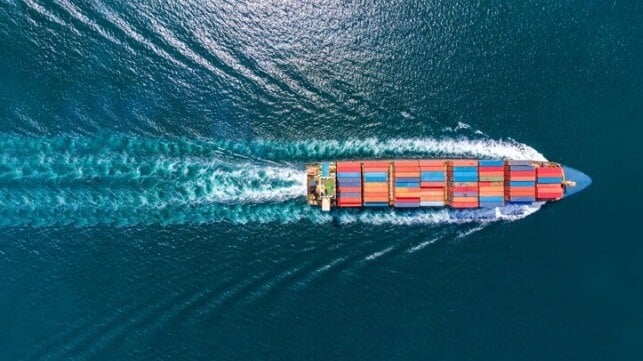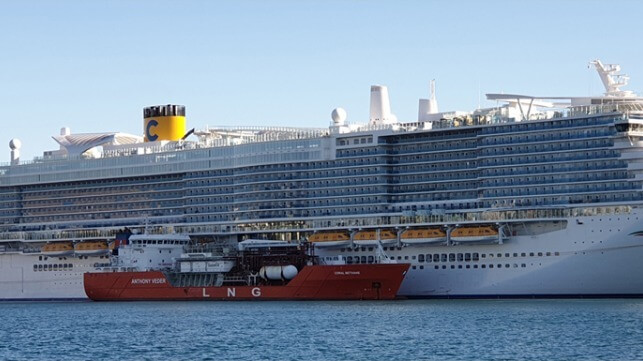Report: Targeted Subsidies, Hefty GHG Levy Needed to Ensure E-Fuel Adoption

A new report looking at what will be needed to spur the transition to e-fuels and the early adoption in the maritime sector concludes that targeted subsidies and a hefty GHG levy are needed to close the gap between scalable zero-emission fuels and other compliance options. The analysis was timed to the International Maritime Organization’s upcoming negotiations ahead of the Maritime Environment Protection Committee (MEPC) meeting this summer to adopt the second phase of the strategy for the decarbonization of the shipping industry.
“The path the sector is on now requires urgent and drastic correction from both commercial and policy actions to avoid significant risks to the sector and global trade,” warns the report presented by the UCL Energy Institute and maritime consultancy UMAS. “Without maximum efficiency,” the report warns, “the transition will be more expensive, more difficult and disruptive, and more prone to failure and delay.”
The research set out to explore how the transition can be stimulated, coordinated, and delivered, not just by the IMO, but also national governments, regional bodies, and industry stakeholders. They analyzed the viability and costs of the IMO’s Revised Strategy targets released after the 2024 MEPC session.
The study concludes that the transition from fossil fuels in shipping has much in common with other transitions but that current policies of fuel standards and a flexible financial mechanism, even with a multiplier that boosts credits for e-fuel, are unlikely to start an e-fuel transition before 2040. Further, they warn the industry risks becoming locked into alternatives that could make long-term decarbonization goals more difficult.
“This new analysis shows that the market will struggle to make an e-fuel business case before 2040, and therefore e-fuels such as green ammonia will not be available for shipping’s use in any volume,” says Dr. Tristan Smith, Professor of Energy and Transport at the UCL Energy Institute. “Some suggest that the role of a GHG levy is only for addressing equity, this study shows that it is not the only role, it is also a critical enabler of shipping’s energy transition and for minimizing the long-run costs to trade.”
GHG pricing starting at $30 per tonne of CO2e, the research warns looks unlikely to provide certainty of support to enable the energy transition to start and scale through the 2027-2035 period, and certainly would be unable to additionally support a just and equitable transition. They conclude that GHG pricing starting at $150 per tonne of CO2e, could generate sufficient revenue to support both the energy transition and ensure a just and equitable transition for affected communities.
Using the total cost of ownership approach, the study modeled a 14,000 TEU container vessel with different technology and fuel options. They used this to evaluate the effects of policy combinations (including a GHG Fuel Intensity (GFI) requirement, flexibility mechanism, and a levy and subsidy/reward mechanism) currently under discussion at the IMO.
They believe the early low-cost routes to compliance could become uncompetitive within a decade. The study says that early action is needed to support e-fuels to bridge the gap between e-fuels and low-cost early compliance options such as LNG, biofuels, and carbon capture and storage. They believe that a GHG levy and targeted incentive for e-fuels, such as a subsidy/reward that would be derived from the GHG Levy, is critical to ensure the industry is moving quickly on the correct transition course. The report says that there are political, technical, economic and commercial requirements to deliver on the goals for decarbonization.
Feasibility Studies ID Technology to Address Fugitive Methane Emissions

An industry collaboration known as the Safetytech Accelerate reports its latest round of supported feasibility studies has shown strong potential to cut fugitive methane emissions in the maritime industry. They report after the successful studies efforts are now underway to advance these research projects to on-ship trials as soon as possible.
Fugitive emissions happen across the LNG supply chain ranging from loading to engine delivery. While short-lived they represent another source of harmful unburnt methane entering the environment in addition to the more widely discussed methane slip where unburnt methane enters the exhaust during the combustion problem.
The Safetytech Accelerator launched its flagship Methane Abatement Maritime Innovation Initiative (MAMII) in September 2022 bringing together industry leaders, technology innovators, and maritime stakeholders with a focus on measuring and mitigating methane emissions in the maritime sector and also seeks to promote the adoption of solutions to reduce and eliminate methane emissions. This latest effort involved industry leaders Chevron, Carnival Corporation, Shell, and Seapeak as well as three technology supplies.
The group reports that identifying, quantifying, and mitigating fugitive emissions is another element of the effort. It says that it is another essential element to achieve industry-wide decarbonization goals.
Three companies and their technologies were the focus of the completed technology feasibility studies. Xplorobot which provides handheld devices and an AI-powered platform to detect and measure fugitive emissions studied the warm side of the gas fuel line evaluating the efficacy of the technology in detecting and quantifying methane emissions. For this technology, the next step is to deploy the kit in the field to further validate and optimize the technology.
A second study explored acoustic cameras from Sorama evaluating the viability for monitoring on LNG carriers. Strategically placed and handheld cameras detect the emissions by visualizing sound and vibration fields in 3D. A six-month pilot scoped the use of four fixed cameras aboard. They believe it demonstrated a capability to quickly identify the source of emissions and would provide a cost-effective option for ship operators.
Framergy studied its technology which would be used to store and purify methane to significantly reduce emissions during planned and unplanned venting events. The methane would be captured and stored at a lower pressure than conventional methods using the company’s filtering membrane made of a metal-organic framework material. Captured methane has the possibility of reuse or sale.
The Safetytech Accelerator reports the three studies show the potential to detect, measure, and mitigate methane emissions on LNG-powered ships. While methane slip – the unburnt release of methane during combustion – remains the largest source of methane emissions, they believe this work adds another critical element to the overall effort addressing methane emissions. The group is also supporting efforts to reduce emissions from engine exhausts.
The Anchor Partners for the MAMII effort total more than 20 leading shipping and energy companies. Beyond the four companies that participated in these studies, others working with the effort include MSC, Lloyd’s Register, GTT, NYK, Mitsui O.S.K., CMA CGM, and others.
No comments:
Post a Comment